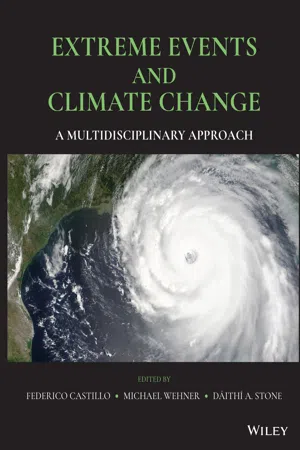
Extreme Events and Climate Change
A Multidisciplinary Approach
- English
- ePUB (mobile friendly)
- Available on iOS & Android
Extreme Events and Climate Change
A Multidisciplinary Approach
About this book
An authoritative volume focusing on multidisciplinary methods to estimate the impacts of climate-related extreme eventsto society
As the intensity and frequency of extreme events related to climate change continue to increase, there is an urgent need for clear and cohesive analysis that integrates both climatological and socioeconomic impacts. Extreme Events and Climate Change provides a timely, multidisciplinary examination of the impacts of extreme weather under a warming climate. Offering wide-ranging coverage of the methods and analysis that relate changes in extreme events to their societal impacts, this volume helps readers understand and overcome the methodological challenges associated with extreme event analysis.
Contributions from leading experts from across disciplines describe the theoretical requirements for analyzing the complex interactions between meteorological phenomena and the resulting outcomes, discuss new approaches for analyzing the impacts of extreme events on society, and illustrate how empirical and theoretical concepts merge to form a unified plan that enables informed decision making. Throughout the text, innovative frameworks allow readers to find solutions to the modeling and statistical challenges encountered when analyzing extreme events. Designed for researchers and policy makers alike, this important resource:
- Discusses topics central to understanding how extreme weather changes as the climate warms
- Provides coverage of analysis methods that relate changes in extreme events to their societal impacts
- Reviews significant theoretical and modeling advances in the physical aspects of climate science
- Presents a comprehensive view of state of the science, including new ways of using data from different sources
Extreme Events and Climate Change: A Multidisciplinary Approach is an indispensable volume for students, researchers, scientists, and practitioners in fields such as hazard and risk analysis, climate change, atmospheric and ocean sciences, hydrology, geography, agricultural science, and environmental and space science.
Frequently asked questions
- Essential is ideal for learners and professionals who enjoy exploring a wide range of subjects. Access the Essential Library with 800,000+ trusted titles and best-sellers across business, personal growth, and the humanities. Includes unlimited reading time and Standard Read Aloud voice.
- Complete: Perfect for advanced learners and researchers needing full, unrestricted access. Unlock 1.4M+ books across hundreds of subjects, including academic and specialized titles. The Complete Plan also includes advanced features like Premium Read Aloud and Research Assistant.
Please note we cannot support devices running on iOS 13 and Android 7 or earlier. Learn more about using the app.
Information
1
Synthesizing Observed Impacts of Extreme Weather Events Across Systems
ABSTRACT
This chapter discusses synthesis assessments of the impacts of extreme weather across multiple types of impacts. It considers existing global synthesis efforts rather than developing a new analysis based on other chapters in this book. It includes discussion of the motivation for such assessments, challenges in performing syntheses related to extremes, and possible methods for assembling a synthesis. The focus is on the detection and attribution of impacts during the past half‐century, but implications for predicting and, ultimately, documenting future changes in risk are also discussed. The only synthesis assessment of past impacts related to extreme weather is reviewed, noting that its shortcomings can be overcome only through further developments in a number of areas, including monitoring and process understanding.
1.1. A REASON FOR CONCERN
1.2. OF TRUTHS AND TRIVIALITIES
1.2.1. Weather Extremes or Impact Extremes?
Table of contents
- Cover
- Table of Contents
- Title Page
- Copyright Page
- Contributors
- Preface
- Acknowledgments
- 1 Synthesizing Observed Impacts of Extreme Weather Events Across Systems
- 2 The Impact of Heat Waves on Agricultural Labor Productivity and Output
- 3 Weather Extremes That Affect Various Agricultural Commodities
- 4 Economics of the Impact of Climate Change on Agriculture
- 5 Agricultural Losses in a Telecoupled World
- 6 Perceptions of Extreme Weather Events and Adaptation Decisions
- 7 Simulation Model Based on Agents for Land Use Change and Cost‐Benefit Analysis of Land Management Policies
- 8 Climate Extremes, Political Participation, and Migration Intentions of Farmers
- 9 Effects of Extreme Weather Events on Internal Migration in Rural Guatemala
- 10 Extreme Heat Exposure and Occupational Health in a Changing Climate
- 11 Tropical Cyclone Impacts
- 12 On the Relationship Between Heat Waves and Extreme Precipitation in a Warming Climate
- 13 Evaluating Economic Output at Risk to Climate Change
- Index
- End User License Agreement